Roberts A.D. The Cambridge History of Africa, Volume 7: from 1905 to 1940
Подождите немного. Документ загружается.

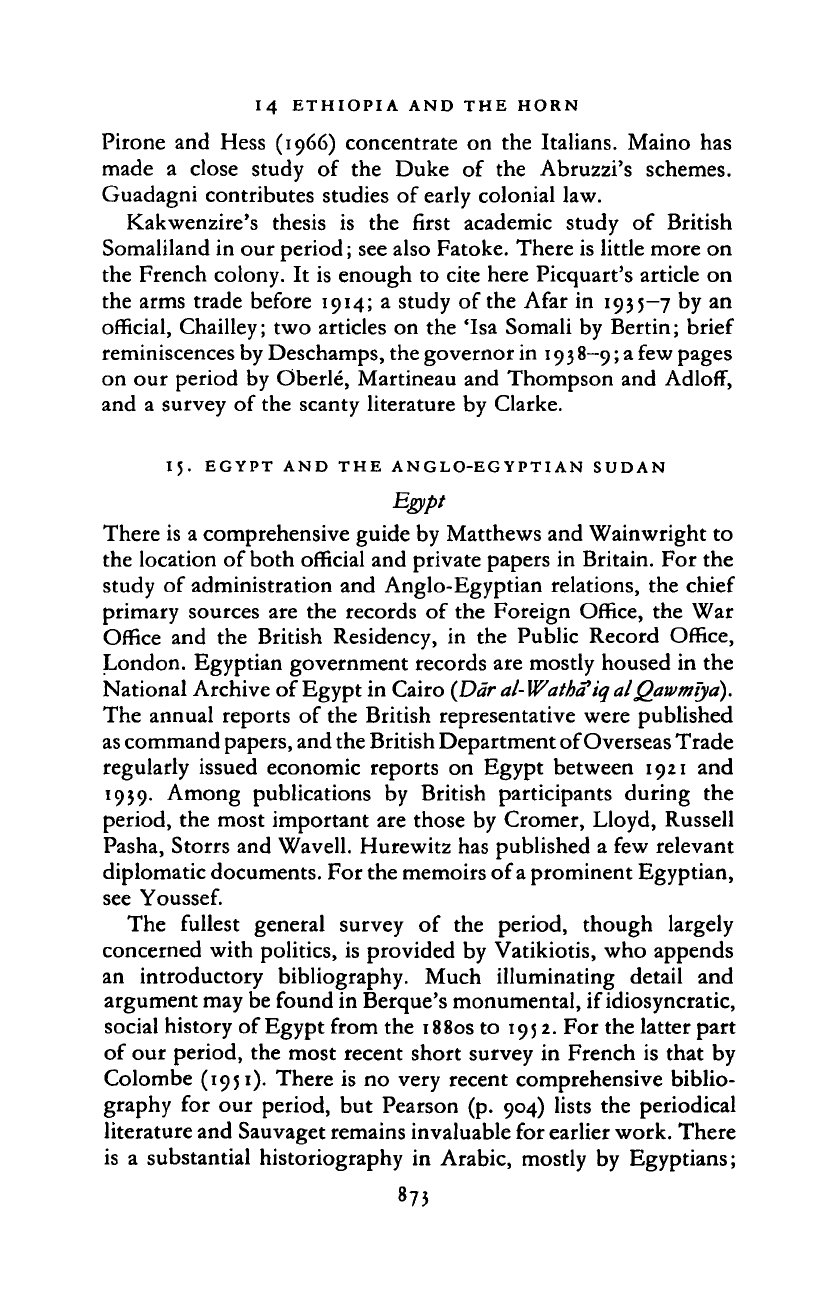
14 ETHIOPIA AND THE HORN
Pirone and Hess (1966) concentrate on the Italians. Maino has
made
a
close study
of
the Duke
of
the Abruzzi's schemes.
Guadagni contributes studies of early colonial law.
Kakwenzire's thesis
is the
first academic study
of
British
Somaliland in our period; see also Fatoke. There is little more on
the French colony.
It
is enough to cite here Picquart's article on
the arms trade before 1914;
a
study of the Afar in 1935-7 by an
official, Chailley; two articles on the 'Isa Somali by Bertin; brief
reminiscences by Deschamps, the governor in
1938-9;
a few pages
on our period by Oberle, Martineau and Thompson and
Adloff,
and a survey of the scanty literature by Clarke.
IJ. EGYPT AND THE ANGLO-EGYPTIAN SUDAN
Egypt
There is a comprehensive guide by Matthews and Wainwright to
the location of both official and private papers in Britain. For the
study of administration and Anglo-Egyptian relations, the chief
primary sources are the records
of
the Foreign Office, the War
Office and the British Residency,
in
the Public Record Office,
London. Egyptian government records are mostly housed in the
National Archive of Egypt in Cairo
(Ddr al-Watha'iq
atQawmiyd).
The annual reports of the British representative were published
as
command
papers,
and the British Department of Overseas Trade
regularly issued economic reports
on
Egypt between 1921 and
1939.
Among publications
by
British participants during
the
period, the most important are those by Cromer, Lloyd, Russell
Pasha, Storrs and Wavell. Hurewitz has published a few relevant
diplomatic documents. For the memoirs of
a
prominent Egyptian,
see
Youssef.
The fullest general survey
of the
period, though largely
concerned with politics, is provided by Vatikiotis, who appends
an introductory bibliography. Much illuminating detail
and
argument may be found in Berque's monumental, if idiosyncratic,
social history of Egypt from the 1880s to 1952. For the latter part
of our period, the most recent short survey in French is that by
Colombe (1951). There is no very recent comprehensive biblio-
graphy for our period, but Pearson (p. 904) lists the periodical
literature and Sauvaget remains invaluable for earlier work. There
is
a
substantial historiography
in
Arabic, mostly by Egyptians;
873
Cambridge Histories Online © Cambridge University Press, 2008
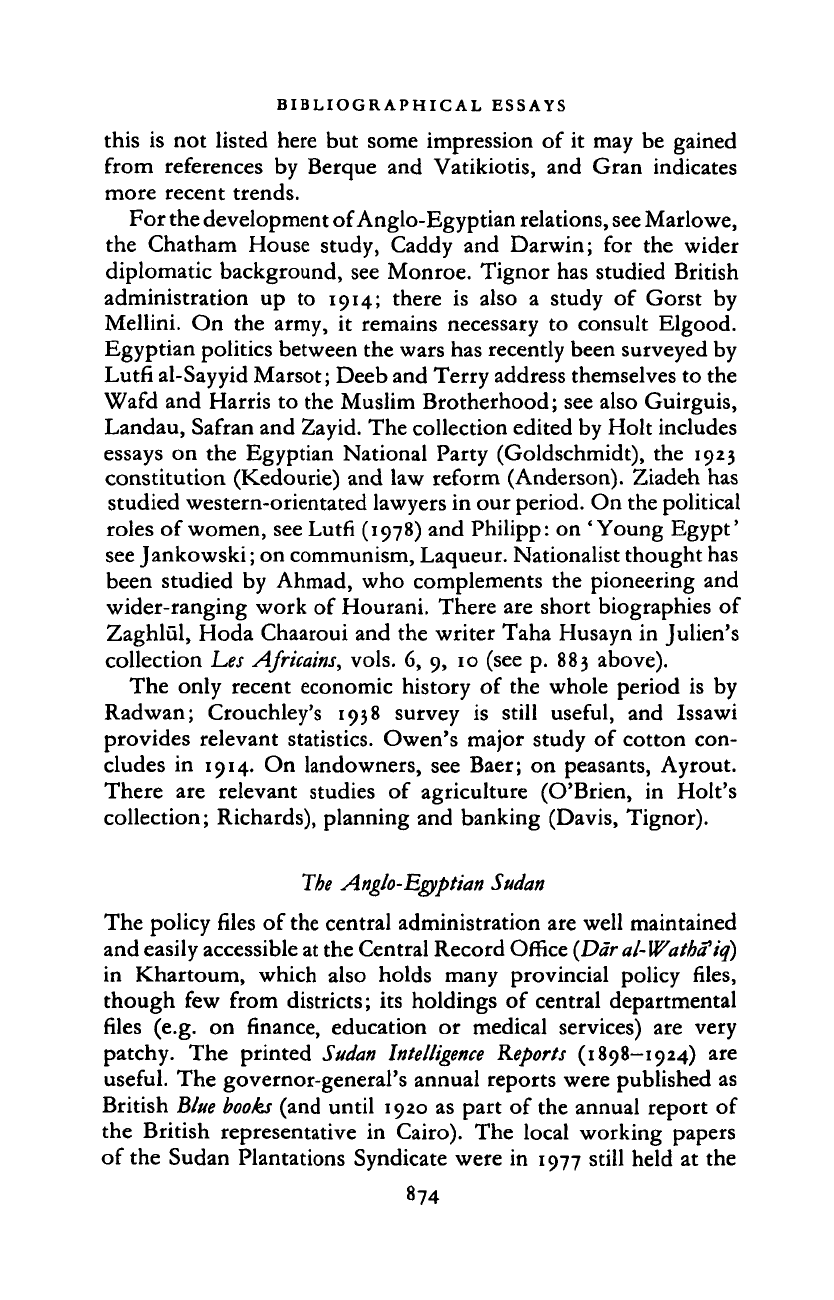
BIBLIOGRAPHICAL ESSAYS
this
is
not listed here but some impression of it may be gained
from references by Berque and Vatikiotis, and Gran indicates
more recent trends.
For the development of Anglo-Egyptian relations,
see
Marlowe,
the Chatham House study, Caddy and Darwin;
for
the wider
diplomatic background, see Monroe. Tignor has studied British
administration
up to
1914; there
is
also
a
study
of
Gorst
by
Mellini. On the army,
it
remains necessary
to
consult Elgood.
Egyptian politics between the wars has recently been surveyed by
Lutfi al-Sayyid Marsot; Deeb and Terry address themselves to the
Wafd and Harris to the Muslim Brotherhood; see also Guirguis,
Landau, Safran and Zayid. The collection edited by Holt includes
essays on the Egyptian National Party (Goldschmidt), the 1923
constitution (Kedourie) and law reform (Anderson). Ziadeh has
studied western-orientated lawyers in our period. On the political
roles of women, see Lutfi (1978) and Philipp: on 'Young Egypt'
see Jankowski; on communism, Laqueur. Nationalist thought has
been studied by Ahmad, who complements the pioneering and
wider-ranging work of Hourani. There are short biographies of
Zaghlul, Hoda Chaaroui and the writer Taha Husayn in Julien's
collection Les Africains, vols. 6, 9, 10 (see p. 883 above).
The only recent economic history
of
the whole period
is
by
Radwan; Crouchley's 1938 survey
is
still useful,
and
Issawi
provides relevant statistics. Owen's major study of cotton con-
cludes
in
1914. On landowners, see Baer; on peasants, Ayrout.
There
are
relevant studies
of
agriculture (O'Brien,
in
Holt's
collection; Richards), planning and banking (Davis, Tignor).
The Anglo-Egyptian Sudan
The policy files of the central administration are well maintained
and easily accessible at the Central Record Office (Dar al-WathS'iq)
in Khartoum, which also holds many provincial policy files,
though few from districts; its holdings
of
central departmental
files (e.g.
on
finance, education
or
medical services) are very
patchy. The printed Sudan
Intelligence
Reports (1898-1924)
are
useful. The governor-general's annual reports were published as
British
Blue books
(and until 1920 as part of the annual report of
the British representative
in
Cairo). The local working papers
of the Sudan Plantations Syndicate were in 1977 still held at the
874
Cambridge Histories Online © Cambridge University Press, 2008
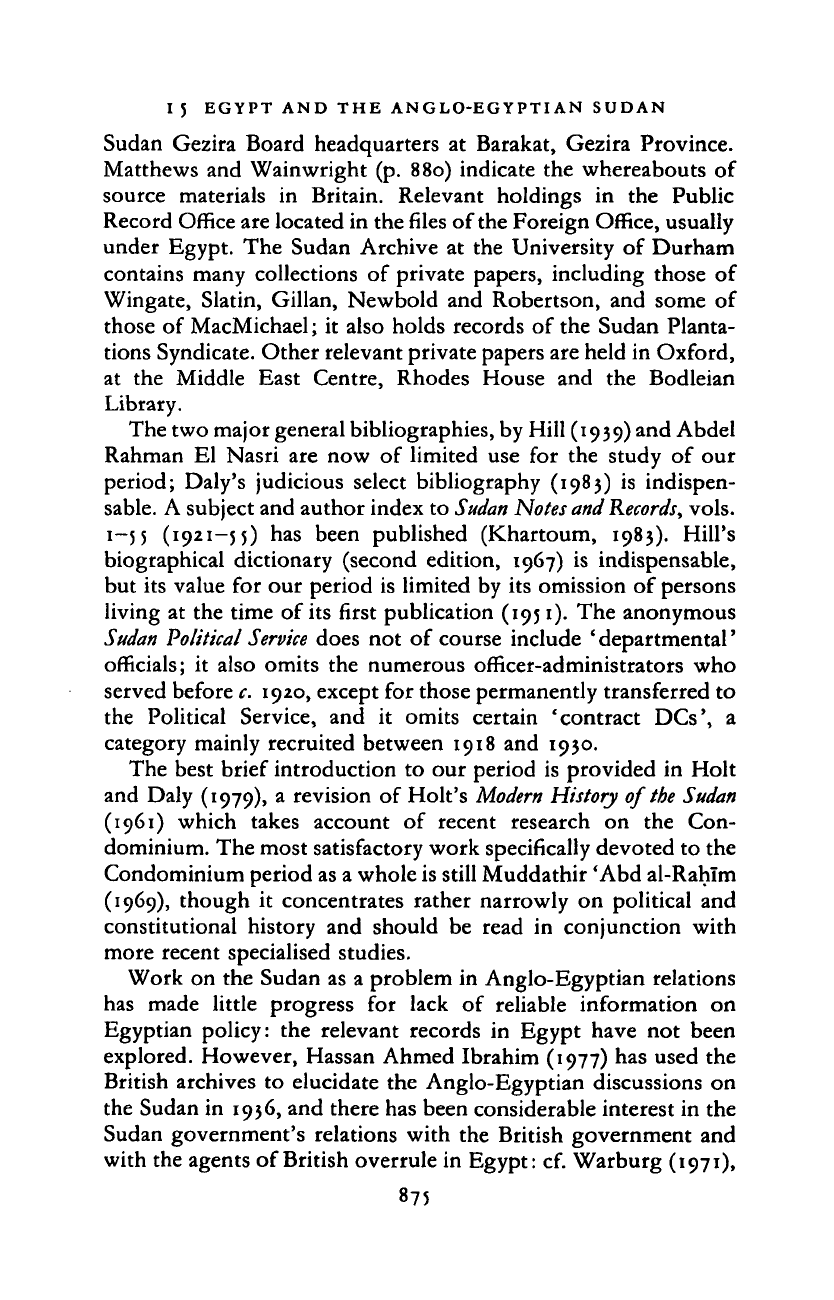
I 5 EGYPT AND THE ANGLO-EGYPTIAN SUDAN
Sudan Gezira Board headquarters at Barakat, Gezira Province.
Matthews and Wainwright (p. 880) indicate the whereabouts of
source materials in Britain. Relevant holdings in the Public
Record Office are located in the files of the Foreign Office, usually
under Egypt. The Sudan Archive at the University of Durham
contains many collections of private papers, including those of
Wingate, Slatin, Gillan, Newbold and Robertson, and some of
those of MacMichael; it also holds records of the Sudan Planta-
tions Syndicate. Other relevant private papers are held in Oxford,
at the Middle East Centre, Rhodes House and the Bodleian
Library.
The two major general bibliographies, by Hill (1939) and Abdel
Rahman El Nasri are now of limited use for the study of our
period; Daly's judicious select bibliography (1983) is indispen-
sable. A subject and author index to
Sudan Notes and
Records,
vols.
1-55 (1921-55) has been published (Khartoum, 1983). Hill's
biographical dictionary (second edition, 1967) is indispensable,
but its value for our period is limited by its omission of persons
living at the time of its first publication (1951). The anonymous
Sudan Political Service
does not of course include ' departmental'
officials; it also omits the numerous officer-administrators who
served before
c.
1920, except for those permanently transferred to
the Political Service, and it omits certain 'contract DCs', a
category mainly recruited between 1918 and 1930.
The best brief introduction to our period is provided in Holt
and Daly (1979), a revision of Holt's
Modern History
of
the Sudan
(1961) which takes account of recent research on the Con-
dominium. The most satisfactory work specifically devoted to the
Condominium period as a whole is still Muddathir 'Abd al-Rahlm
(1969),
though it concentrates rather narrowly on political and
constitutional history and should be read in conjunction with
more recent specialised studies.
Work on the Sudan as a problem in Anglo-Egyptian relations
has made little progress for lack of reliable information on
Egyptian policy: the relevant records in Egypt have not been
explored. However, Hassan Ahmed Ibrahim (1977) has used the
British archives to elucidate the Anglo-Egyptian discussions on
the Sudan in 1936, and there has been considerable interest in the
Sudan government's relations with the British government and
with the agents of British overrule in Egypt: cf. Warburg (1971),
875
Cambridge Histories Online © Cambridge University Press, 2008

BIBLIOGRAPHICAL ESSAYS
Daly (1980, 1983) and G. N. Sanderson (in Babikr Badrl). The
social origins, educational background and professional ethos of
the Sudan Political Service have been investigated
by
Collins
(1972),
Kirk-Greene, Mangan
and
Grandin (who bases
her
treatment on replies
to a
questionnaire administered
to
certain
former members of the
service).
Relevant reminiscences by former
officials include Jackson, Davies
and
Boustead; much more
revealing, however, is the selection by Henderson and Owen of
the more printable versified persiflage, satire
and
invective
composed, originally for private circulation, by British political
officers. Henderson's valuable Life and Letters
of
Newbold
is
unfortunately still unique.
The structure
and
policies
of
Wingate's administration,
especially in the northern Sudan, have been carefully analysed by
Warburg (1971); G. N. Sanderson
(in
Babikr Badrl) traces
its
origins
as an
improvised 'civil affairs branch'
of
the Egyptian
Army.
The
role
of
Slatin
is
perceptively sketched
by
Hill
(1965).
Bukhari illustrates Wingate's preoccupation with internal
security. Islamic resistance is investigated by Cudsi and by Hassan
Ahmed Ibrahim (1979);
a
very different Islamic response
is
exemplified
in
Babikr Badrl's memoirs. By
far
the best general
treatment of the period between the wars is, most unfortunately,
still unpublished: Bakheit's 1965 thesis. For the economic and
political crises, and the policy fluctuations, which marked the
governor-generalship of Lee Stack, Daly (1980) is
a
reliable and
perceptive guide. For the crisis of 1924, Babikr Badrl is a virtually
unique Sudanese testimony; Schuster (p. 887) sheds important
light on the friction between the governments of the Sudan and
Britain. On the White Flag League, Bakheit is still indispensable,
though see also 'Abd al-Karlm al-Sa'Id (in Arabic), Muddathir
'Abd al-Rahlm (1969), Beshir (1974) and Daly (1980).
The years from 1925
to
1939 were dominated by the rise of
neo-Mahdism and the development
of
' sectarian' politics; and,
after the brief fiasco
of
Archer's governor-generalship,
by
the
sharply contrasted policies of Maffey and Symes. On Archer, see
his own memoirs
(p.
986), those
of
Schuster
(p.
887),
and
G. N. Sanderson
(in
Babikr Badrl).
On
neo-Mahdism, Babikr
Badrl and Sadiq al-Mahdlare valuable testimonies; Bakheit (1965)
is supplemented, but not superseded, by Beshir (1974), Hassan
Ahmed Ibrahim (1974,1977) and Warburg (1978). However, until
876
Cambridge Histories Online © Cambridge University Press, 2008
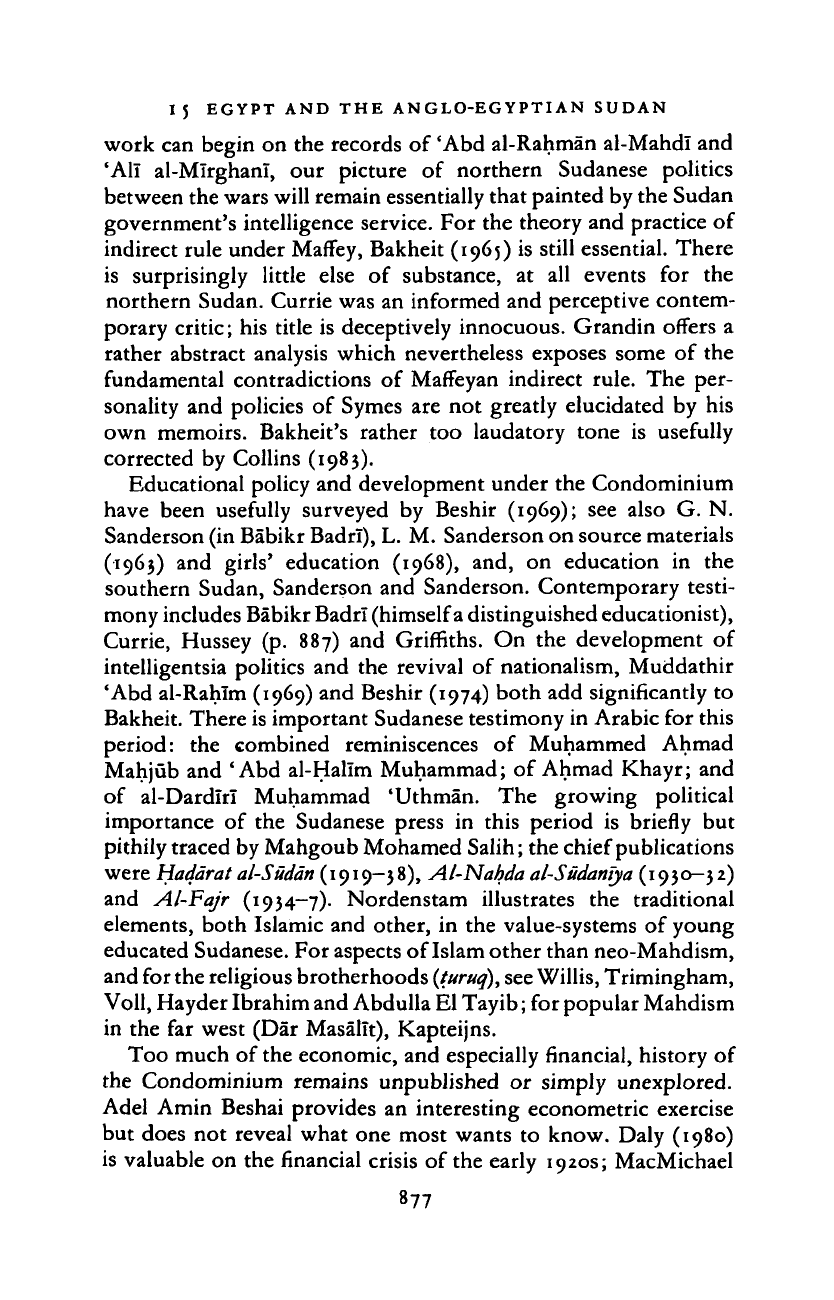
IJ EGYPT AND THE ANGLO-EGYPTIAN SUDAN
work can begin on the records of 'Abd al-Rahman al-Mahdl and
'All al-Mlrghanl,
our
picture
of
northern Sudanese politics
between the wars will remain essentially that painted by the Sudan
government's intelligence service. For the theory and practice of
indirect rule under Maffey, Bakheit (1965) is still essential. There
is surprisingly little else
of
substance,
at all
events
for the
northern Sudan. Currie was an informed and perceptive contem-
porary critic; his title is deceptively innocuous. Grandin offers
a
rather abstract analysis which nevertheless exposes some of the
fundamental contradictions
of
Maffeyan indirect rule. The per-
sonality and policies
of
Symes are not greatly elucidated by his
own memoirs. Bakheit's rather too laudatory tone
is
usefully
corrected by Collins (1983).
Educational policy and development under the Condominium
have been usefully surveyed
by
Beshir (1969); see also G. N.
Sanderson (in Babikr Badrl), L. M. Sanderson on source materials
(1963) and girls' education (1968), and,
on
education
in the
southern Sudan, Sanderson and Sanderson. Contemporary testi-
mony includes Babikr Badrl (himself
a
distinguished educationist),
Currie, Hussey (p. 887) and Griffiths. On the development
of
intelligentsia politics and the revival of nationalism, Muddathir
'Abd al-Rahlm (1969) and Beshir (1974) both add significantly to
Bakheit. There is important Sudanese testimony in Arabic for this
period:
the
combined reminiscences
of
Muhammed Ahmad
Mahjub and 'Abd al-Hallm Muhammad; of Ahmad Khayr; and
of al-Dardlrl Muhammad 'Uthman.
The
growing political
importance
of
the Sudanese press
in
this period
is
briefly
but
pithily traced by Mahgoub Mohamed Salih; the chief publications
were Haddrat
al-Suddn
(1919—38), Al-Nahda
al-Sudantya
(1930—32)
and Al-Fajr (1934-7). Nordenstam illustrates
the
traditional
elements, both Islamic and other, in the value-systems of young
educated Sudanese. For aspects of Islam other than neo-Mahdism,
and for the religious brotherhoods
(turuq),
see
Willis,
Trimingham,
Voll, Hayder Ibrahim and Abdulla El Tayib; for popular Mahdism
in the far west (Dar Masallt), Kapteijns.
Too much of the economic, and especially financial, history of
the Condominium remains unpublished
or
simply unexplored.
Adel Amin Beshai provides an interesting econometric exercise
but does not reveal what one most wants to know. Daly (1980)
is valuable on the financial crisis of the early 1920s; MacMichael
877
Cambridge Histories Online © Cambridge University Press, 2008
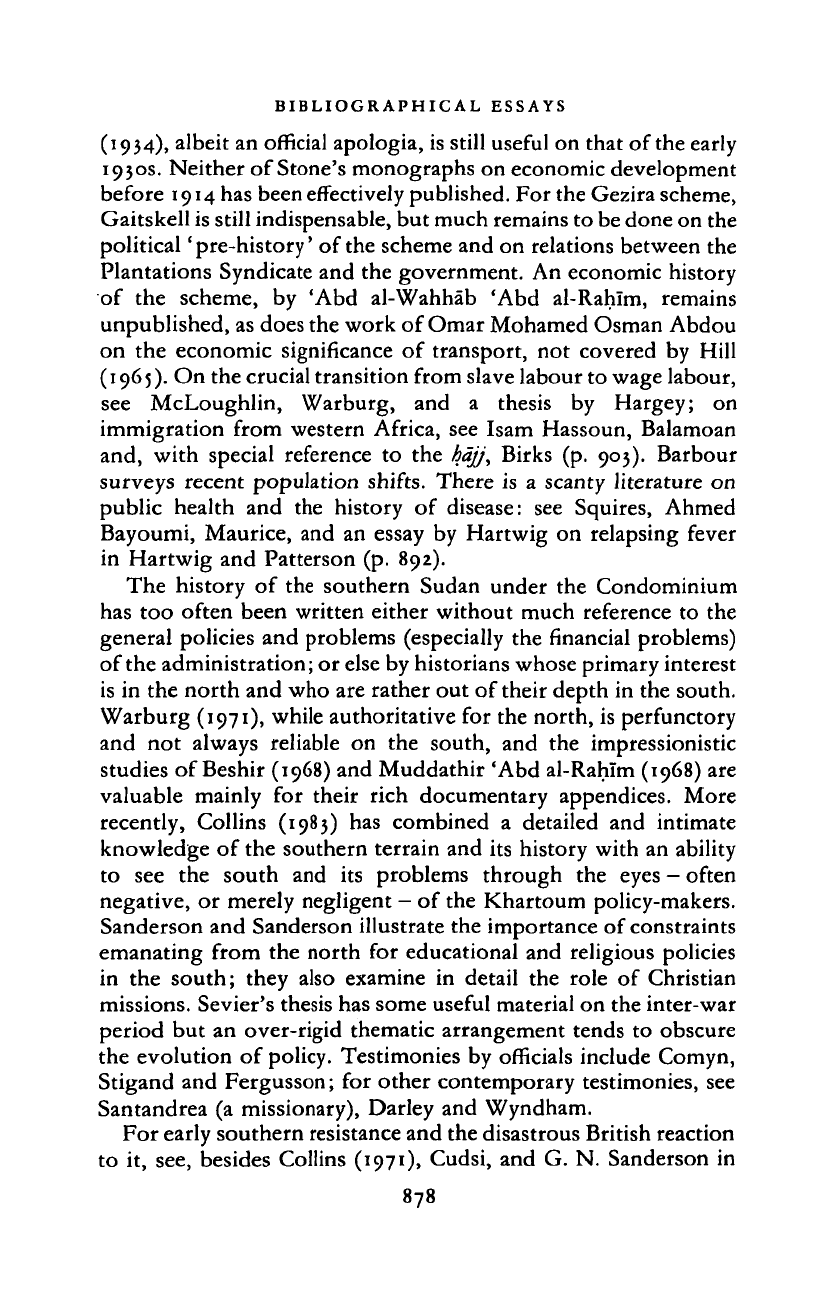
BIBLIOGRAPHICAL ESSAYS
(1934),
albeit an official apologia, is still useful on that of the early
1930s. Neither of Stone's monographs on economic development
before 1914 has been effectively published. For the Gezira scheme,
Gaitskell is still indispensable, but much remains to be done on the
political 'pre-history' of the scheme and on relations between the
Plantations Syndicate and the government. An economic history
of the scheme,
by
'Abd al-Wahhab 'Abd al-Rahlm, remains
unpublished, as does the work of Omar Mohamed Osman Abdou
on the economic significance
of
transport, not covered by Hill
(1965).
On the crucial transition from slave labour to wage labour,
see McLoughlin, Warburg,
and a
thesis
by
Hargey;
on
immigration from western Africa, see Isam Hassoun, Balamoan
and, with special reference
to
the bajj, Birks (p. 903). Barbour
surveys recent population shifts. There is
a
scanty literature on
public health and the history
of
disease: see Squires, Ahmed
Bayoumi, Maurice, and an essay by Hartwig on relapsing fever
in Hartwig and Patterson (p. 892).
The history
of
the southern Sudan under the Condominium
has too often been written either without much reference to the
general policies and problems (especially the financial problems)
of the administration; or else by historians whose primary interest
is in the north and who are rather out of their depth in the south.
Warburg (1971), while authoritative for the north, is perfunctory
and not always reliable
on the
south, and the impressionistic
studies of Beshir (1968) and Muddathir 'Abd al-Rahlm (1968) are
valuable mainly
for
their rich documentary appendices. More
recently, Collins (1983) has combined
a
detailed and intimate
knowledge of the southern terrain and its history with an ability
to
see the
south
and its
problems through
the
eyes
—
often
negative, or merely negligent
—
of the Khartoum policy-makers.
Sanderson and Sanderson illustrate the importance of constraints
emanating from the north for educational and religious policies
in the south; they also examine
in
detail the role
of
Christian
missions. Sevier's thesis has some useful material on the inter-war
period but an over-rigid thematic arrangement tends to obscure
the evolution of policy. Testimonies by officials include Comyn,
Stigand and Fergusson; for other contemporary testimonies, see
Santandrea (a missionary), Darley and Wyndham.
For early southern resistance and the disastrous British reaction
to it, see, besides Collins (i97i)> Cudsi, and G. N. Sanderson in
878
Cambridge Histories Online © Cambridge University Press, 2008
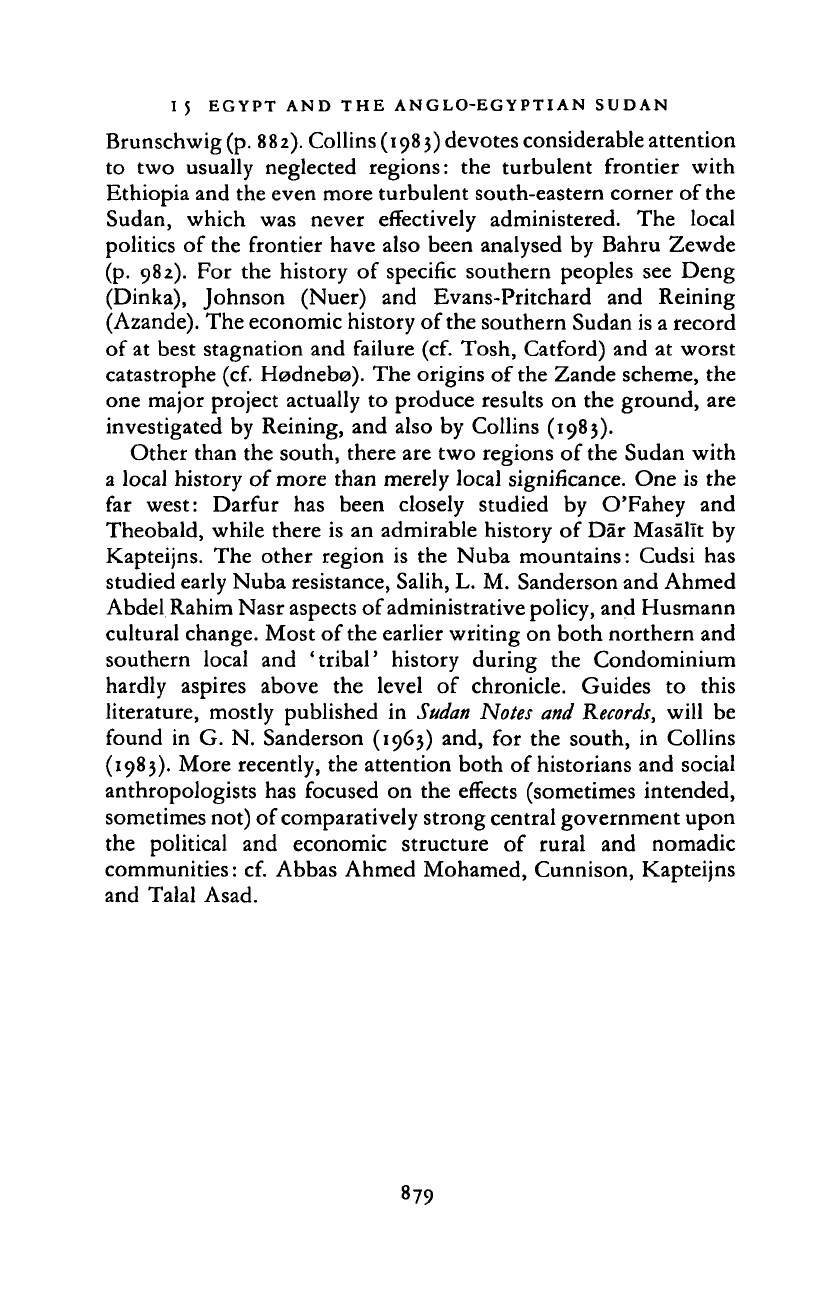
I 5 EGYPT AND THE ANGLO-EGYPTIAN SUDAN
Brunschwig
(p.
882). Collins (1983) devotes considerable attention
to two usually neglected regions:
the
turbulent frontier with
Ethiopia and the even more turbulent south-eastern corner of the
Sudan, which
was
never effectively administered.
The
local
politics of the frontier have also been analysed by Bahru Zewde
(p.
982). For the history
of
specific southern peoples see Deng
(Dinka), Johnson (Nuer)
and
Evans-Pritchard
and
Reining
(Azande). The economic history of the southern Sudan is a record
of at best stagnation and failure (cf. Tosh, Catford) and
at
worst
catastrophe (cf. Hodnebo). The origins of the Zande scheme, the
one major project actually to produce results on the ground, are
investigated by Reining, and also by Collins (1983).
Other than the south, there are two regions of the Sudan with
a local history of more than merely local significance. One is the
far west: Darfur
has
been closely studied
by
O'Fahey
and
Theobald, while there is an admirable history of Dar Masallt by
Kapteijns. The other region
is
the Nuba mountains: Cudsi has
studied early Nuba resistance, Salih, L. M. Sanderson and Ahmed
Abdel Rahim Nasr aspects of administrative policy, and Husmann
cultural change. Most of the earlier writing on both northern and
southern local
and
'tribal' history during
the
Condominium
hardly aspires above
the
level
of
chronicle. Guides
to
this
literature, mostly published
in
Sudan
Notes and
Records,
will
be
found
in
G. N. Sanderson (1963) and,
for
the south,
in
Collins
(1983).
More recently, the attention both of historians and social
anthropologists has focused on the effects (sometimes intended,
sometimes not) of comparatively strong central government upon
the political
and
economic structure
of
rural
and
nomadic
communities: cf. Abbas Ahmed Mohamed, Cunnison, Kapteijns
and Talal Asad.
879
Cambridge Histories Online © Cambridge University Press, 2008
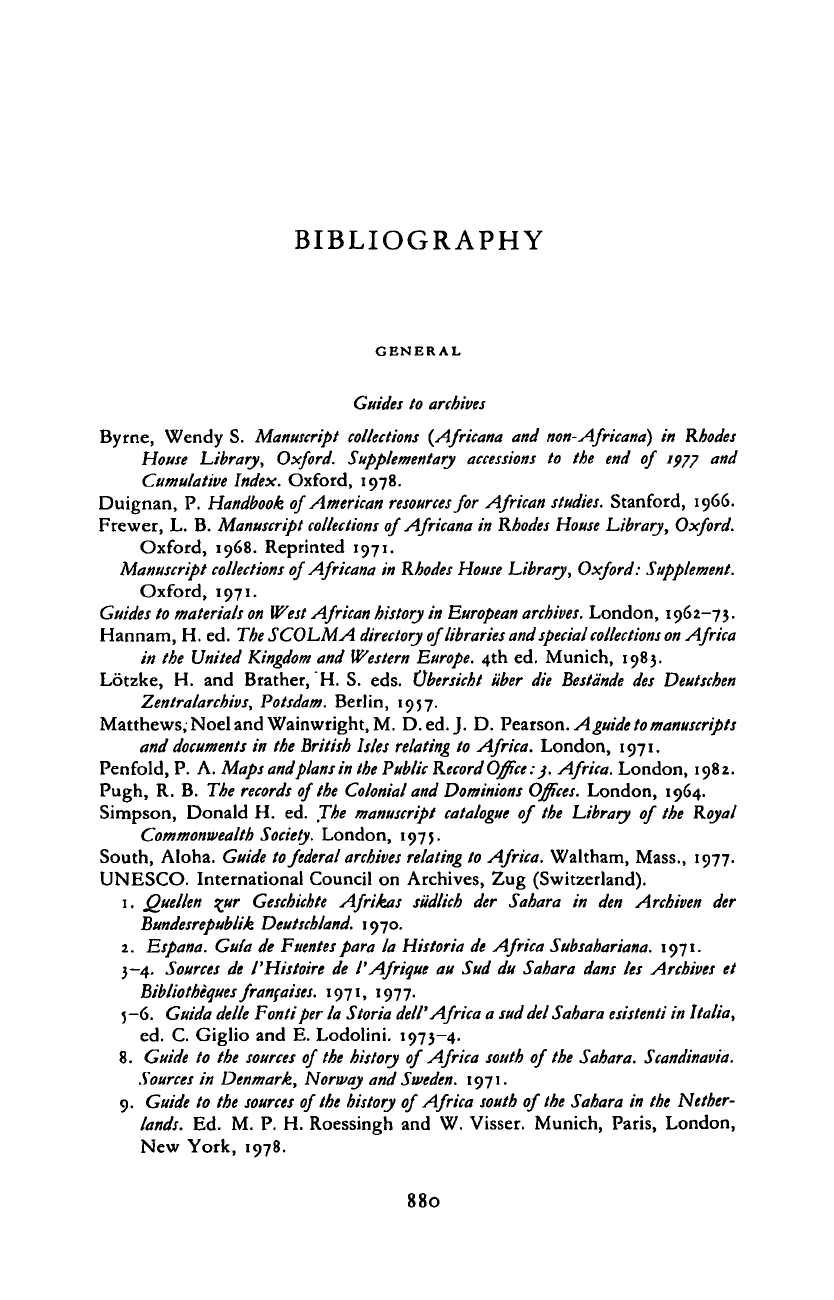
BIBLIOGRAPHY
GENERAL
Guides
to
archives
Byrne, Wendy
S.
Manuscript
collections
{Africana
and
non-Africana)
in
Rhodes
House Library,
Oxford.
Supplementary accessions
to the end of
1977
and
Cumulative Index. Oxford,
1978.
Duignan,
P.
Handbook
of
American resources for African studies. Stanford,
1966.
Frewer,
L. B.
Manuscript
collections
of
Africana
in
Rhodes House Library,
Oxford.
Oxford,
1968.
Reprinted
1971.
Manuscript
collections
of Africana
in
Rhodes House Library,
Oxford:
Supplement.
Oxford,
1971.
Guides to materials
on
West African history in European
archives.
London, 1962-73.
Hannam,
H. ed.
The SCOLMA
directory
of
libraries
and special
collections on
Africa
in
the
United Kingdom
and
Western Europe.
4th
ed.
Munich,
1983.
Lotzke,
H. and
Brather,
H. S. eds.
Ubersicht iiber
die
Bestdnde
des
Deutschen
Zentralarchivs, Potsdam. Berlin,
1957.
Matthews, Noel and Wainwright, M. D.ed.J.
D.
Pearson. A
guide to manuscripts
and
documents
in
the
British Isles relating
to
Africa. London,
1971.
Penfold,
P. A.
Maps andplans in the Public Record Office:
j.
Africa. London, 1982.
Pugh,
R. B.
The
records
of
the
Colonial and Dominions
Offices.
London,
1964.
Simpson, Donald
H. ed. The
manuscript catalogue
of
the
Library
of
the Royal
Commonwealth Society. London,
1975.
South, Aloha. Guide to federal
archives
relating
to
Africa. Waltham, Mass.,
1977.
UNESCO. International Council
on
Archives,
Zug
(Switzerland).
1. Quellen
%ur
Geschichte Afrikas sud Itch
der
Sahara
in den
Archiven
der
Bundesrepublik Deutschland.
1970.
2.
Espana. Guia de
Fuentes
para
la
Historia de Africa Subsahariana.
1971.
3-4. Sources
de
I'Histoire
de
I'Afrique
au Sud du
Sahara dans
les
Archives
et
Bibliotbeaues franfaises. 1971,
1977.
5-6. Guida
delle
Fontiper la Storia dell' Africa
a
sud del Sahara esistenti in Italia,
ed.
C.
Giglio
and E.
Lodolini. 1973—4.
8.
Guide
to
the
sources
of
the history
of
Africa south
of
the Sahara. Scandinavia.
Sources
in
Denmark, Norway and
Sweden.
1971.
9. Guide
to
the
sources
of
the
history
of
Africa south
of
the
Sahara
in
the Nether-
lands.
Ed. M. P. H.
Roessingh
and W.
Visser. Munich, Paris, London,
New York,
1978.
880
Cambridge Histories Online © Cambridge University Press, 2008
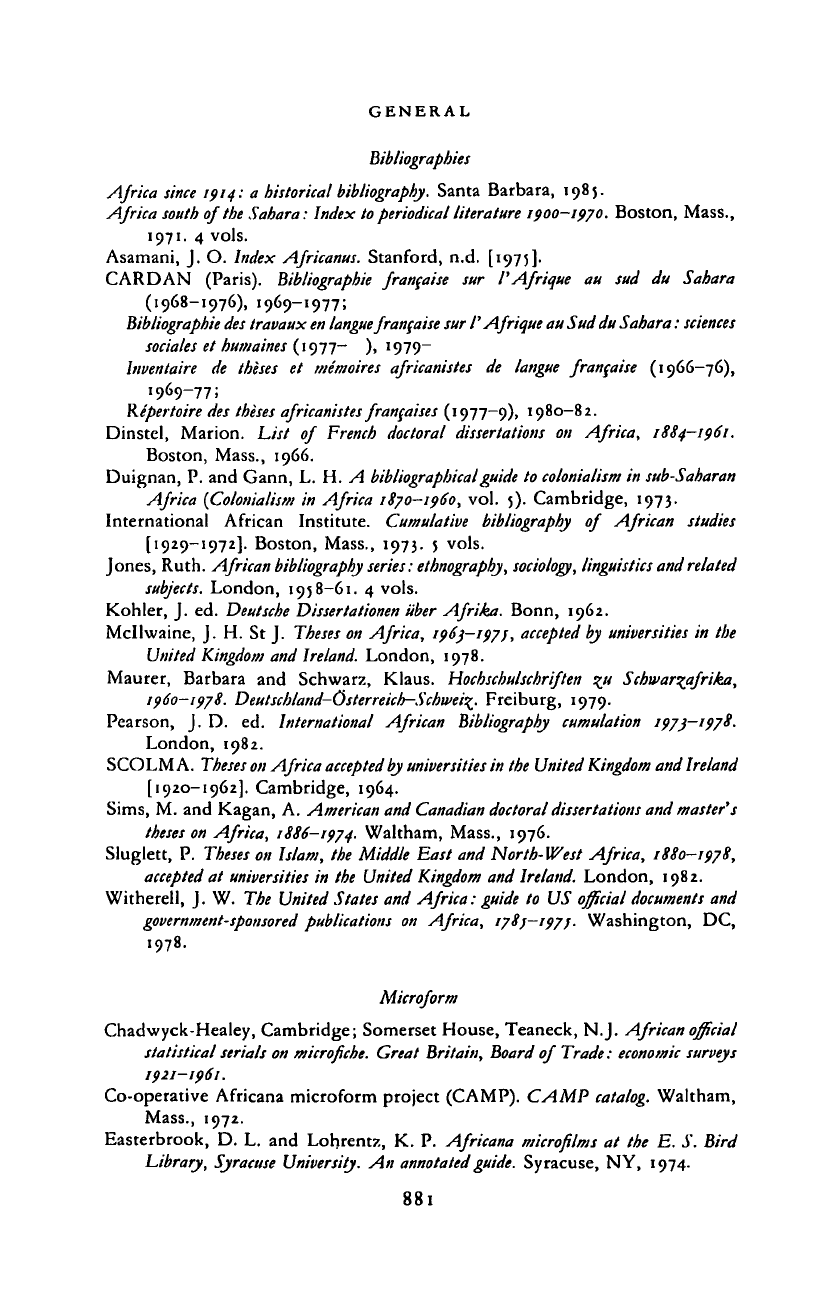
GENERAL
Bibliographies
Africa
since
1914: a historical
bibliography.
Santa Barbara, 1985.
Africa south of the Sahara: Index
to periodical
literature 1900-19/0. Boston, Mass.,
1971.
4 vols.
Asamani, J. O. Index Africanus. Stanford, n.d. [1975].
CARDAN (Paris). Bibliographie franfaise sur I'Afrique au sud du Sahara
(1968-1976), 1969-1977;
Bibliographie des
travaux
en
langue francaise sur I'Afrique
au
Sud
du
Sahara:
sciences
sociales
et humaines (1977- ), 1979-
bwentaire de theses et memoires africanistes de langue franfaise (1966-76),
1969-77;
Repertoire des
theses
africanistes franfaises (1977-9), 1980-82.
Dinstel, Marion. List of French doctoral dissertations on Africa, 1884-1961.
Boston, Mass., 1966.
Duignan, P. and Gann, L. H. A bibliographical guide to
colonialism
in sub-Saharan
Africa {Colonialism in Africa 1870-1960, vol. 5). Cambridge, 1973.
International African Institute. Cumulative bibliography of African studies
[1929-1972].
Boston, Mass., 1973. 5 vols.
Jones,
Ruth. African
bibliography
series:
ethnography,
sociology,
linguistics
and
related
subjects. London,
1958-61.
4 vols.
Kohler, J. ed. Deutsche Dissertationen iiber Afrika. Bonn, 1962.
Mcllwaine, J. H. St J. Theses on Africa, 1963-197/,
accepted
by universities in the
United Kingdom and
Ireland.
London, 1978.
Maurer, Barbara and Schwarz, Klaus. Hochschulschriften £// Schwar^afrika,
1960-19/8. Deutschland-Qsterreich-Scbwei^. Freiburg, 1979.
Pearson, J. D. ed. International African Bibliography cumulation 19/3-19/8.
London, 1982.
SCOLM A.
Theses on
Africa accepted
by universities
in the United
Kingdom
and
Ireland
[1920-1962].
Cambridge, 1964.
Sims,
M. and Kagan, A. American and Canadian
doctoral dissertations
and master's
theses
on Africa, 1886-19/4. Waltham, Mass., 1976.
Sluglett, P. Theses on Islam, the Middle East and North-West Africa, 1880-19/8,
accepted
at universities in the United Kingdom and
Ireland.
London, 1982.
Witherell, J. W. The United States and Africa: guide to US official
documents
and
government-sponsored
publications on Africa, r/8j-19//. Washington, DC,
1978.
Microform
Chadwyck-Healey, Cambridge; Somerset House, Teaneck, N.J. African
official
statistical serials on
microfiche.
Great Britain, Board of Trade:
economic
surveys
1921—1961.
Co-operative Africana microform project (CAMP). CAM?
catalog.
Waltham,
Mass.,
1972.
Easterbrook, D. L. and Lohrentz, K. P. Africana microfilms at the E. S. Bird
Library, Syracuse University. An annotated guide. Syracuse, NY, 1974.
881
Cambridge Histories Online © Cambridge University Press, 2008
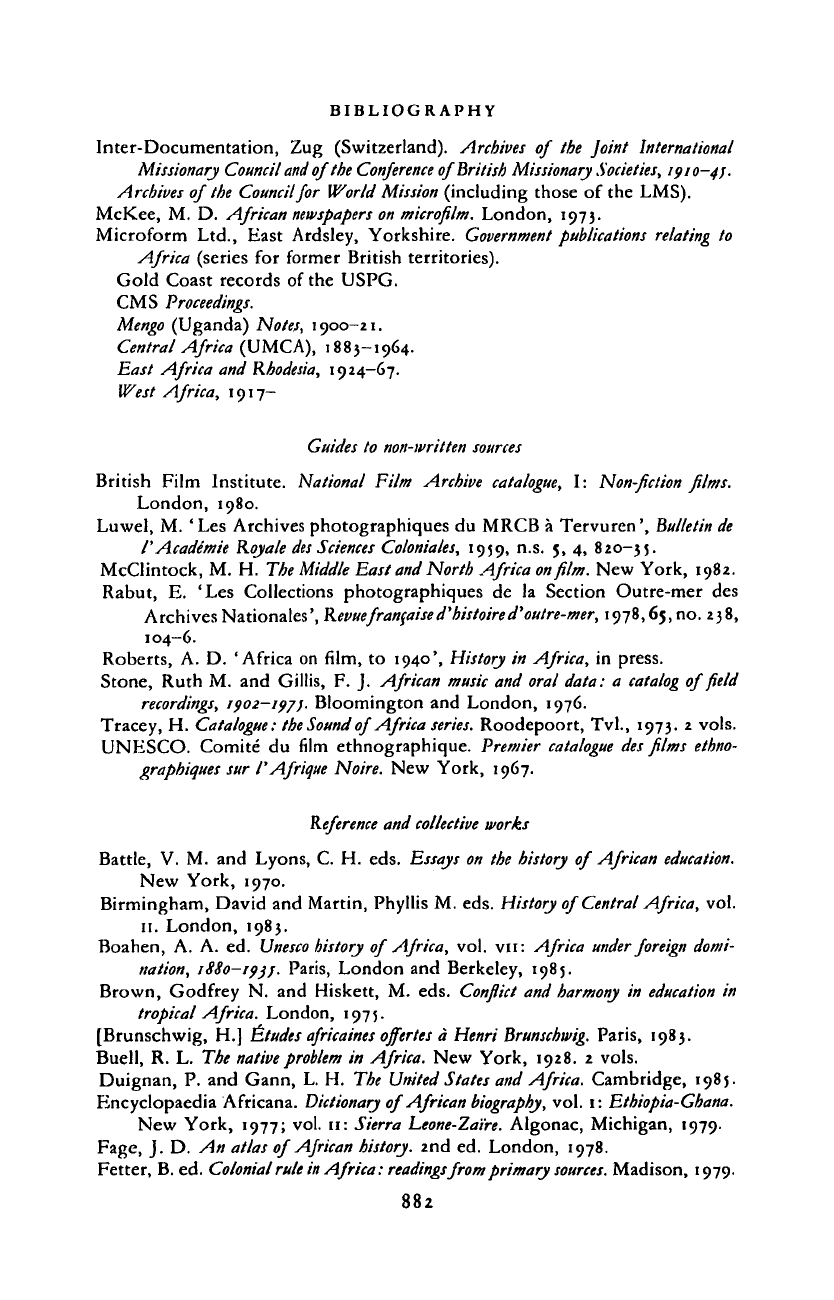
BIBLIOGRAPHY
Inter-Documentation, Zug (Switzerland). Archives of the Joint
International
Missionary Council and
of
the Conference
of
British Missionary
Societies,
/9/0-4;.
Archives of
the
Council for World
Mission
(including those of the LMS).
McKee, M. D. African
newspapers on
microfilm.
London, 1973.
Microform Ltd., East Ardsley, Yorkshire.
Government publications relating
to
Africa (series for former British territories).
Gold Coast records of the USPG.
CMS Proceedings.
Mengo
(Uganda) Notes,
1900-21.
Central
Africa (UMCA), 1883-1964.
East Africa and
Rhodesia,
1924-67.
West Africa, 1917-
Guides
to
non-written sources
British Film Institute. National Film Archive
catalogue,
I: Non-fiction films.
London, 1980.
Luwel, M. 'Les Archives photographiques du MRCB a Tervuren',
Bulletin de
I'Academie
Rqyale des Sciences
Coloniales,
1959, n.s. 5, 4,
820-35.
McClintock, M. H.
The Middle
East
and
North Africa
on
film.
New York, 1982.
Rabut, E. 'Les Collections photographiques de la Section Outre-mer des
Archives Nationales',
Revuefrancaised'histoired''outre-mer,
1978,65^0. 238,
104-6.
Roberts, A. D. 'Africa on film, to 1940',
History
in Africa, in press.
Stone, Ruth M. and Gillis, F. J. African
music
and
oral
data: a
catalog
of field
recordings,
1902-197}.
Bloomington and London, 1976.
Tracey, H.
Catalogue:
the Sound
of Africa
series.
Roodepoort, Tvl., 1973. 2 vols.
UNESCO. Comite du film ethnographique.
Premier catalogue
des
films
ethno-
graphiques
sur /''Afrique Noire. New York, 1967.
Reference and collective
works
Battle, V. M. and Lyons, C. H. eds.
Essays
on the
history
of African
education.
New York, 1970.
Birmingham, David and Martin, Phyllis M. eds.
History
of
Central
Africa, vol.
11.
London, 1983.
Boahen, A. A. ed.
Unesco history
of Africa, vol. vn: Africa
under foreign
domi-
nation,
iSSo-rpjj. Paris, London and Berkeley, 1985.
Brown, Godfrey N. and Hiskett, M. eds.
Conflict
and
harmony
in
education
in
tropical
Africa. London, 1975.
[Brunschwig, H.]
Etudes africaines offertes
a Henri
Brunschwig.
Paris, 1983.
Buell, R. L. The
native problem
in Africa. New York, 1928. 2 vols.
Duignan, P. and Gann, L. H. The
United States and
Africa. Cambridge, 1985.
Encyclopaedia Africana.
Dictionary
of African
biography,
vol. 1:
Ethiopia-Ghana.
New York, 1977; vol.
11:
Sierra
Leone-Zaire.
Algonac, Michigan, 1979.
Fage, J. D. An atlas of
African
history.
2nd ed. London, 1978.
Fetter, B. ed. Colonial
rule in
Africa: readings from
primary
sources.
Madison, 1979.
882
Cambridge Histories Online © Cambridge University Press, 2008
